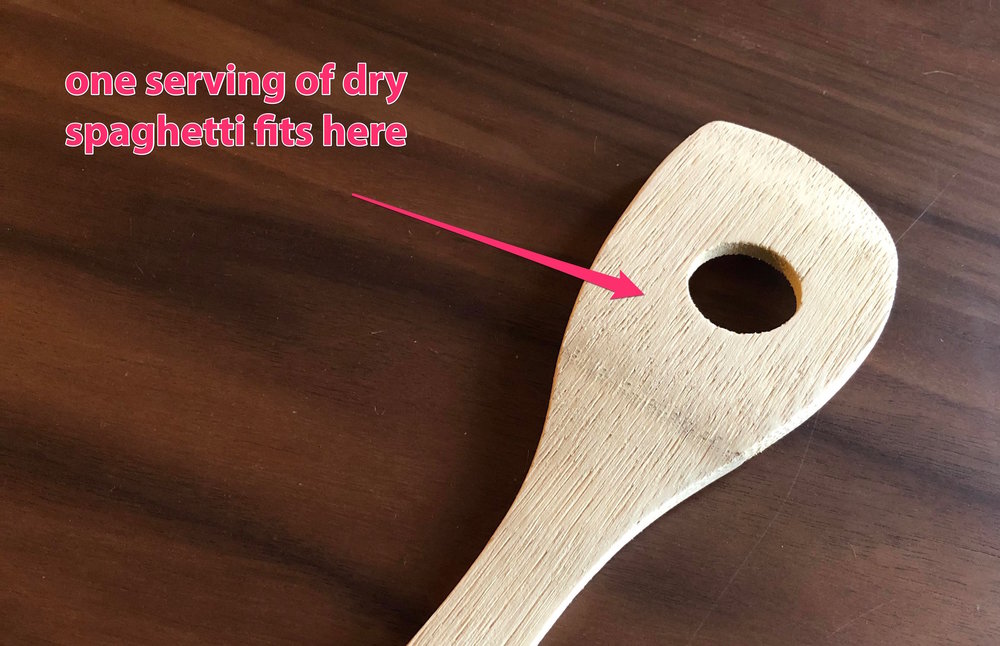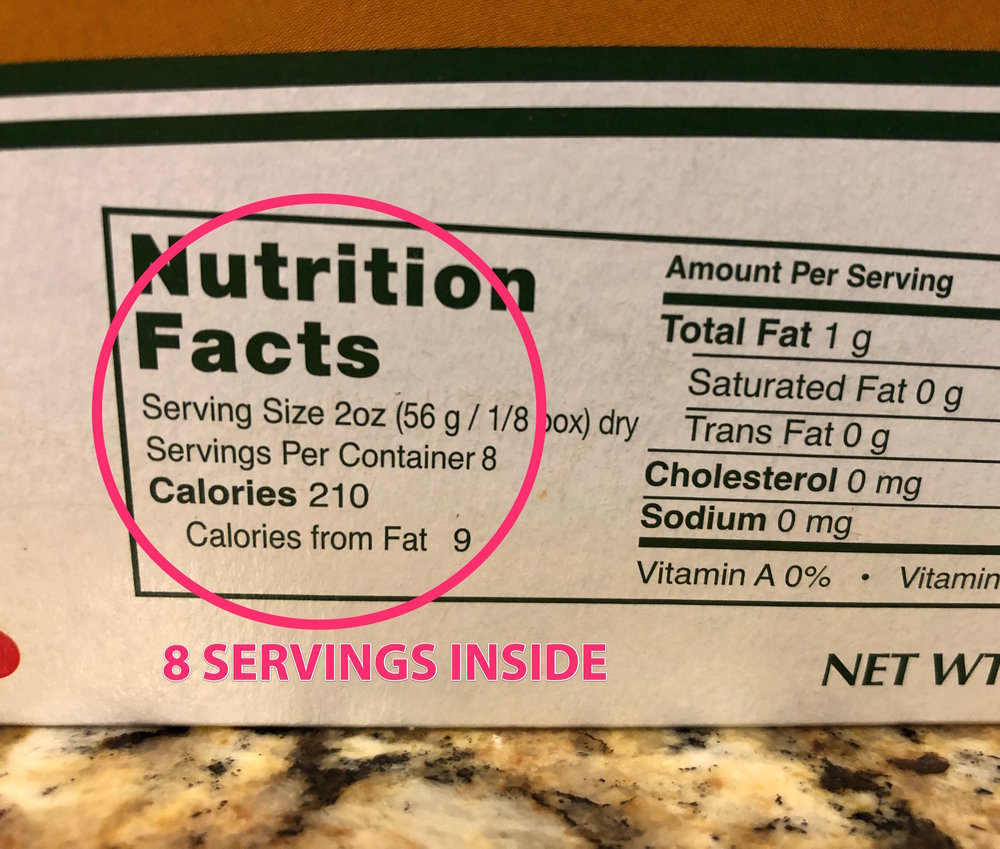Pasta is one of the most difficult foods to fit into your diet.
The biggest problem? It’s delicious and easy to eat too much of it!
But beyond that, pasta is extremely difficult to measure accurately without a scale, so it’s hard to know how many calories you’re really eating.
Pasta is also notoriously high in calories, so that standard 2oz serving of dry pasta is actually way, way less than you would think.
Most of us probably eat 2-3 servings of pasta with a standard meal by just eyeballing what seems reasonable.
If you want some way to measure your pasta without a scale, try these extremely rough guidelines:
- A cup of cooked pasta = One serving
- The more empty space the pasta has (spaghetti and angel hair have almost none… penne has a lot), the more you’ll need to err in one direction or another
- A serving of penne is closer to a heaping cup, cooked.
- For long, thin pasta like spaghetti, go just a bit under the cup mark.
- For macaroni, hit the cup mark dead on.
This is just a very broad overview that’ll help you estimate in a pinch.
Depending on your pasta, and your patience, there are lots of ways to measure pasta without buying a food scale. So let’s dive into this topic in a little more detail.
Measuring dry pasta (without a scale)
If you’re cooking yourself, and especially for yourself, it might be best to measure the amount of pasta you need before you cook it.
I’ve done this plenty of times while making spaghetti for one. You don’t want to waste extra noodles, or possibly worse, end up eating far more than you should.
According to a study done by Hungry Girl, most pastas roughly double in size when cooked.
- Using the “one cup cooked = one serving” guideline, you can estimate that about a half cup of dry pasta is about a serving.
- (This method works great with macaroni, penne, rigatoni, and other smaller noodles that can fit into a measuring cup. Err on the side of more pasta when the noodles are voluminous (like penne))
- A 2oz serving of dry spaghetti is about the diameter of a quarter when bunched in your fist.
- Spaghetti is best measured in bunches and by circumference. You can get one of those cool spaghetti measuring tools if you want, but there’s really no need.
- A 2oz serving of lasagna is about 2 flat sheets of lasagna uncooked.
- Egg noodles typically don’t expand as much during cooking.
- About a cup of dry egg noodles should be a regular serving size.
(For a cool trick, you can also use the opening of a standard soda bottle to measure the right amount of spaghetti.)
Measuring pasta after it’s cooked
If you’re making enough pasta for a group or someone else is cooking (or you’re eating at a restaurant), it’s going to be really hard to pre-measure your pasta.
(Also, kind of rude to the cook if you’re a guest! “Hey, can I measure my pasta first?”)
We already mentioned that roughly a cup of cooked pasta should equal a serving.
But if you’re out at a restaurant or eating as a guest somewhere, you’ll have to eyeball it.
It’s going to vary widely between people, but the size of your fist is a pretty good rough guideline for a serving of cooked pasta (about 1 cup).
Also, just assume that if a host is serving you pasta, you’re going to get more than one serving on your plate.
(A cool trick if you’re serving a large group: Heap cooked spaghetti noodles into a muffin tin. Each muffin section is about one serving.)
The pasta spoon method (for spaghetti or thin noodles)

Ever notice your pasta spoon has a hole in the middle of it?
That’s partially to help the water drain out, but it’s also roughly the equivalent size of one serving of spaghetti.
This only works if your pasta spoon has a relatively round hole in the middle and not just a slot for water drainage.
It’s a very similar trick to measuring spaghetti by diameter using a quarter or an open soda bottle, with the added advantage that you’re more likely to have a pasta spoon handy if you’re cooking pasta!
(If you want a more precise way of doing this that you’ll always have handy (as opposed to dirty in the dishwasher when you need it most!) check out this simple, effective spaghetti measure on Amazon.)
The division method

This one is a bit of a pain in the butt, but if you’re cooking for yourself and have a little patience, it can be pretty effective.
Every package of pasta should tell you (under Nutritional Facts) how many servings are inside the package.
So if you want to cook one serving of pasta, simply empty the entire package and divide the noodles the proper number of individual servings.
This will take some time and will require some counter space!
But it’s actually a great trick for prep and meal planning… Do this once and individually bag the noodles for easy-to-grab, single servings of pasta whenever you need them.
(The number of servings inside each package may not be 100% accurate, but it should be pretty close. And if you’ve done a good job diving the noodles, any error calories should be relatively equally spread across each portion! You could do a lot worse than using this method.)
How many calories are in a single serving of pasta?
Those teeny, tiny servings we talked about above?
(As in, barely a cup of cooked noodles? Or a pile of noodles roughly the size of your fist?)
Their physical size is the only thing small about them.
A single serving of cooked pasta usually has about 200 calories.
(Obviously, this will depend heavily on the type of pasta and the brand…
… and for a slightly lower calorie count, better vitamin levels, higher protein content, and healthier fats, it’s worth going for the whole wheat pasta.)
That actually doesn’t sound so bad.
Until you consider that we haven’t added ANYTHING to it yet.
It’s just a wet pile of warm noodles.
200 is just the starting point (again, for a pretty small portion… about half or a third of what we’d probably serve ourselves by eyeball alone) before we add protein, cheese, sauce, vegetables, etc.
And speaking of adding to pasta…
Hidden calories in pasta
Not only is pasta itself notoriously difficult to measure, and therefore overeat, it also has a way of hiding extra calories.
(If you’re here because you’re trying to measure the right amount of pasta for a diet, pay attention!)
If you put a little olive oil in the water or on the boiled noodles, that counts. If you shake a little parmesan cheese on top, that counts.
The sauce counts! Don’t forget to count sauce calories.
A measly half cup of pasta sauce is easily 50 calories or more. And some people put on 2-3 times that amount without adding it to the calorie total.
Wrapping Up
To summarize: Pasta is a pain in the butt to measure without a scale, though there are lots of pretty effective ways of estimating your serving.
Can pasta fit into a weight loss diet? Absolutely! You’ll just probably need to eat less of it than you think.
(Plus, I wouldn’t want to live without ever eating pasta.)
Hopefully the methods above will help! If you’re super serious about getting your pasta calories exactly right, better just invest in a food scale.
I just started using this one from Etekcity (Amazon link)
Good luck on your diet!
Pasta measurement & calories FAQ
What’s a serving size of dry pasta?
For almost all pastas you buy dry from the store, a single serving is 2oz of uncooked noodles.
Conveniently, this almost always comes out to around 200 calories give or take a few.
Is there a dry to cooked pasta conversion?
It all depends on what kind of pasta you’re cooking, but most noodles go from 2oz uncooked to about 1 cup (give or take 1/4 cup) cooked.
Big, airy noodles (think penne) take up a little more space because of the hollow air in the middle, so something like penne has a serving size of around 1 1/4 cups cooked.
Noodles that are really dense or caloric (like linguine) make a little less than 1 cup cooked per serving.
How many cups of pasta per person?
That all depends on how much you want to eat!
1 cup of cooked pasta is, roughly, 1 serving. (Again, depending on the kind of noodle.) And 1 serving of pasta is usually around 200 calories before adding sauce, oils, meats, and other toppings.
If you’re planning a dinner for many people, 1 serving per person is a decent starting point, but you’ll probably want to make some extra.
For calorie conscious guests, a cool party trick is to serve noodles in a muffin tray (individual servings portioned out) so people can take as much as they want while keeping an eye on portion size.
How many cups is 1lb dry pasta?
A pound (16oz) of dry pasta is equal to about 8 2oz servings. When cooked, that should give you about 8 cups of noodles, give or take depending on the volume of the noodles.
A pound of dry pasta should be enough for 6-8 adults depending on portion size. (I’d aim to be conservative since people often take more than 1 serving each… Realistically, a pound of dry pasta would feed around 6 adults, or maybe even less if your guests have voracious appetites.)
That pasta will go farther with appetizers, sides, and meat and vegetables in the final dish.
How much pasta for 12, 15, or 20 adults?
If you plan on each adult eating one serving of pasta, you’ll want 1 cup cooked pasta per guest.
But realistically, people will eat more than that, and you should be prepared with extra.
Plan on 1.5-2 servings of pasta per person. In very rough terms, again, that’s about 1.5-2 cups of cooked pasta per person, or 3-4 ounces dry pasta.
Refer to the methods above for measuring out your pasta, or simply pick up an inexpensive food scale from Amazon, Bed Bath & Beyond, Target, or any store near you. You can get a good one for under $20.